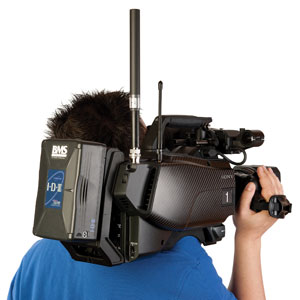Wireless audio keeping up with video counterpart
We’re gaining the freedom of motion to capture images and action without a trail of cable following behind. This is true with video as well as audio.
Wireless microphones have been used with cameras for years, as they provide a variety of benefits to the production. A concealed transmitter and mic on the talent grabs his or her words at a distance with usable level and intelligibility, in sync with the video and without the masking of extraneous noise. Sight lines and sets are cleaner. A clear wireless signal can prove more robust than long cable runs with multiple connections that create the possibility of induced hum or other signal degradation.
The latest generation of wireless mics has drawn on advances in computing, networking and digital audio processing to offer an even more reliable signal — one with a resolution that melds with high-definition visuals provided by new cameras. What are these characteristics, how do they help, and in what ways are they adapted to the needs of today’s camera operator?

Shown here is a BMS HD transmitter hidden inside the pictured Sony camera’s right-side cam shell. Photo courtesy BMS.
Digital wireless
The key word in all of these advances is digital. Within the past couple years, almost all manufacturers of wireless microphones have introduced one or more systems using digital transmission and processing, along with expanded frequency agility and networking capabilities. The transition from analog to digital provides a myriad of benefits.
Modern cameras convert incoming images to digital information, in which form it can remain through processing, editing and transmission through various methods to the viewer. New wireless mics can do the same with the audio signal, making the conversion to digital within the transmitter — right after the microphone capsule. Many new receivers will output the signal in the digital domain, and some cameras will accept this signal directly. So, now both video and audio are digital from the source, and can remain that way until reaching the TV set.
The professional video industry's #1 source for news, trends and product and tech information. Sign up below.
Wider audio bandwidth
One quite beneficial aspect of this capability is audio bandwidth. The typical 24-bit/44kHz or 48kHz sampling rate can yield a virtually flat frequency response from 20Hz to 20+kHz, with any variation coming from the behavior of the particular mic capsule used with the transmitter. Also, companding circuitry with its potential to color the sound — a necessity with analog wireless — is no longer an issue. With digital wireless, high-definition sound joins HD video.
Digital transmissions require a lower signal-to-noise ratio to provide a useable signal. Several benefits arise from this characteristic. Range is usually greater in a digital wireless system for an equivalent RF signal strength from the transmitter.
A number of manufacturers offer variable-level transmitters, allowing the user to select an output sufficient to cover the distance without overly adding to RF congestion. Even the highest output levels are usually below the 50+mW typically used in analog transmitters — leading to a longer battery life of 10 or more hours.
Since the audio signal has been converted to numerical data before it is transmitted and meets error-correction algorithms within the receiver, it is much less prone to signal degradation that affects analog wireless mics. At the receiver output, audio is either excellent or gone. So, possible buzzes, hums, distortions and compromised audio bandwidth are no longer a factor. Greater interference resistance also leads to enhanced reliability, and signal encryption is widely available.
Finding open frequencies
The flexibility that analog frequency-agile wireless brought has been increased with new digital systems. A system that spanned 20MHz to 25MHz of UHF spectrum was the norm, yet new digital systems will operate over a much wider bandwidth. Some cover “only” 64MHz within a single receiver band, while others go beyond 150MHz. With such wide coverage, finding usable wireless channels, even in a crowded RF environment, is assured — without having to carry different bands of receivers and transmitters.
Frequency-agile systems usually have a scanning function that uses the receiver to run through its entire bandwidth and detect existing RF signals and clear spectrum. When the scan completes, it either offers or automatically sets a clear channel, which will then be synced wirelessly via an IR link or manually with the transmitter.
Typically, one frequency from a pre-coordinated group will be selected. Then, additional wireless mics can be set to the group’s other clear channels. In some systems, frequencies can be evenly spaced in open spectrum without interfering with one another.
Monitoring and control
Most professional digital (and analog) wireless receivers have the ability to be networked for monitoring and control. This control can stretch beyond the connected receiver, so frequency and other parameter changes can be made on transmitters without touching them. One new wireless system even has a bi-directional link,with the capability to put a transmitter that is on the talent into sleep mode to conserve battery life.
Some systems are even smart enough to monitor RF environments for problems, select backup frequencies and automatically switch a particular system to a clear channel. Supporting this networking software, both wireless mic manufacturers and third-party vendors provide powerful tools for RF analysis, site surveys and frequency coordination, including: spectrum analysis, visual depiction of your transmitters within the spectrum and alarms that notify of potential problems.
Camera-specific features
When a wireless system is used with a camera, a more stringent set of requirements arises. The typical 1RU or half-rack receiver format in need of an AC plug is much too bulky and heavy, so many manufacturers offer a compatible ENG receiver.
(ALSO SEE: Improved tornado and hurricane coverage/warning systems and ENG's role.)
Many pro cameras provide a slot into which a compatible receiver can be inserted. This allows antennas, controls and display to remain accessible. Wireless mic manufacturers use the dimensions and connection specifications of these slots to design specialized receivers, and some provide several rear-panel kits to correctly interface with particular camera models. When slots are not available, trays and brackets — or even Velcro — allow miniaturized receivers to be attached to the camera.
Because receivers must sometimes endure field conditions, resistance to water, dust, temperature and rough handling must be integrated. In addition, these receivers must be powered during use, either via their own detachable battery packs or through the camera’s battery.
Where is it going?
A prominent manufacturer of both wireless microphones and video cameras has interfaced systems so that when the receiver is mounted in the slot, the camera operator can monitor the status of the wireless mic through the viewfinder, and even control the receiver and transmitter through the camcorder’s menu. Though this degree of integration takes major commitment, it can be expanded by cooperative agreements, common protocols and sharing of information between engineering departments.
In summary, the latest digital wireless systems are keeping up with advances in video technology, giving viewers breathtaking visuals with the dynamic, full-bandwidth audio to match.
—Gary Parks is a freelance writer, formerly with EV, Vega Wireless, Clear-Com and Meyer Sound.
